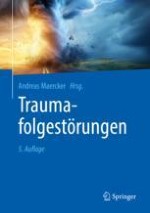2019 | OriginalPaper | Buchkapitel
2. Die posttraumatische Belastungsstörung
verfasst von : A. Maercker, M. Augsburger
Erschienen in: Traumafolgestörungen
Verlag: Springer Berlin Heidelberg
2019 | OriginalPaper | Buchkapitel
verfasst von : A. Maercker, M. Augsburger
Erschienen in: Traumafolgestörungen
Verlag: Springer Berlin Heidelberg
Print ISBN: 978-3-662-58469-9
Electronic ISBN: 978-3-662-58470-5
Copyright-Jahr: 2019
